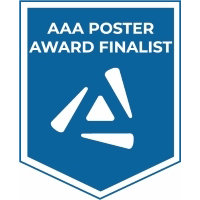Back
ANATOMY
Category: Anatomy
Session: 639 Bones, Cartilage & Teeth
(639.10) Increased Integration in Mutant Mice: An Analysis of the Patterns of Covariance through Ontogeny in Fgfr2 Mice
Monday, April 4, 2022
10:15 AM – 12:15 PM
Location: Exhibit/Poster Hall A-B - Pennsylvania Convention Center
Poster Board Number: C147
Introduction: AAA has separate poster presentation times for odd and even posters.
Odd poster #s – 10:15 am – 11:15 am
Even poster #s – 11:15 am – 12:15 pm
Introduction: AAA has separate poster presentation times for odd and even posters.
Odd poster #s – 10:15 am – 11:15 am
Even poster #s – 11:15 am – 12:15 pm
Miette Ogg (University of Florida), Amanda Pennings (University of Florida), Margaret McNulty (Indiana University School of Medicine), Megan Holmes (Duke University School of Medicine), Jason Mussell (Louisiana State University Health Science Center), Valerie DeLeon (University of Florida)
Miette Ogg
Presenting Author
University of Florida
Presenting Author(s)
Mutations in the FGF/FGFR2 gene result in the premature fusion of fibrous and cartilaginous joints in the skull. This results in profound morphological changes in the skulls of both humans and mice with these mutations. Previous studies have indicated that morphological integration of the skull is expected to become more pronounced in dysmorphic syndromes, including FGFR2 syndromes which result in craniosynostosis. In this study, our objective was to test two hypotheses: 1) that the magnitude of morphological integration was greater in Fgfr2C342Y/+ mutant mice relative to wild-type littermates; and 2) that the magnitude of morphological integration would increase through ontogeny.
Our sample included Fgfr2C342Y/+ mutants and wild-type littermates at postnatal day 14 (P14) and adult stages. We used micro-computed tomography (microCT) scans to create image volumes of the skull. Virtual reconstructions of the cranium were produced in 3DSlicer software, using volume renders based on tissue densities to define the surface of the bone. We collected coordinate data for 38 biologically homologous landmarks with approximately equal distribution across face and neurocranium. All morphometric analyses were conducted using the geomorph package in R. The sample was subdivided by Age and Genotype. Landmark coordinates were divided into face and neurocranium modules. Coordinate data for each subset were superimposed with object symmetry using the bilat.symmetry() function. Covariance across modules was tested using the two.b.pls() function for each sample subset.
Results confirmed our expectation that the magnitude of covariation between face and neurocranium increased in the mutant sample relative to the wild-type sample at both timepoints. Surprisingly, within the mutant sample, integration between face and neurocranium was greater in the younger P14 mice than the older adults. Results of this study can be used to inform researchers about patterns of covariance that can be applied to better understand craniosynostosis syndromes that affect humans.
Funding was provided by NIH/NIDCR 1R03DE019816 and Louisiana Board of Regents LEQSF(2013-14)-ENH-TR-06
Our sample included Fgfr2C342Y/+ mutants and wild-type littermates at postnatal day 14 (P14) and adult stages. We used micro-computed tomography (microCT) scans to create image volumes of the skull. Virtual reconstructions of the cranium were produced in 3DSlicer software, using volume renders based on tissue densities to define the surface of the bone. We collected coordinate data for 38 biologically homologous landmarks with approximately equal distribution across face and neurocranium. All morphometric analyses were conducted using the geomorph package in R. The sample was subdivided by Age and Genotype. Landmark coordinates were divided into face and neurocranium modules. Coordinate data for each subset were superimposed with object symmetry using the bilat.symmetry() function. Covariance across modules was tested using the two.b.pls() function for each sample subset.
Results confirmed our expectation that the magnitude of covariation between face and neurocranium increased in the mutant sample relative to the wild-type sample at both timepoints. Surprisingly, within the mutant sample, integration between face and neurocranium was greater in the younger P14 mice than the older adults. Results of this study can be used to inform researchers about patterns of covariance that can be applied to better understand craniosynostosis syndromes that affect humans.
Funding was provided by NIH/NIDCR 1R03DE019816 and Louisiana Board of Regents LEQSF(2013-14)-ENH-TR-06

